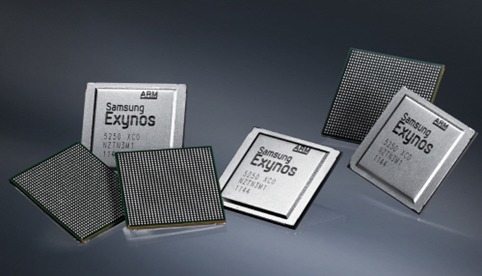
Like it or not, Apple‘s shiny new 64-bit mobile processor has got everyone talking for or against it and even long-time rival Samsung is apparently ready to jump into the wagon. This latest rumor reveals that the company will be showcasing a 64-bit processor in its upcoming Galaxy S5 smartphone, but will be putting in a slight twist.
That twist comes from the manufacturing process. Majority of Samsung’s and other major manufacturers’ chips use a 28nm (nanometer) process, referring to the size of the die or the block of semiconducting material on which the chip is made. According to normal die shrinking conventions, the next smaller die size would be 20nm. However, it seems that the company is somewhat desperate to get an edge over its competitors and will instead be skipping a stage and jumping right down to a 14nm FinFET process.
This process will produce Samsung’s next series of mobile processors, for now dubbed as the Exynos 6 series. Naturally, as the trend goes, Exynos 6 will be 64-bit capable. But more than that, it will be implementing an ARM big.LITTLE architecture, similar to that of announced the Exynos 5 5420 chips. The difference is that Exynos 6 will be sporting a combination of 64-bit ARM chips, the low-power Cortex-A53 and the more powerful Cortex-A57, instead of the usual Cortex-A7/A15 combinations.
Presuming the Exynos 6 news is true, whether or not the Samsung Galaxy S5 will sport such a chip will depend on the timing, not to mention the veracity of rumors. Samsung is said to start production of the Exynos 6 5430 chips late this year and is expected to market it early next year. On the other hand, the Galaxy S5 is rumored to be unveiled at the Mobile World Congress 2014 in February, which could mean that the smartphone might be making a pass on these 64-bit processors.
SOURCE: DDaily
VIA: rbmen, SlashGear










Seems true
size of the die or the smallest feature size?28 nm or 20 nm is not the die size right.. typo
Yeah, I’m assuming that the die would be the size of the entire chip, 14 nm would be the width of individual transistors, or 4 times the transistors per surface area than 28 nm. Possibly running at 5 GHz or twice the speed, although it could run at 10 GHz, it is likely to be lower frequency to save power. 64 bit will allow greater commonalities with for instance desktop graphics, if Nvidia are now making 72 core graphics elements, then 14nm would be 288 cores, or 576 AMD GPU cores, again running at twice the speed. This means 8 times the processing capacity, already at 28 nm mobile chips can run UD (4k) video, such as Snapdragon 800, or Tegra 4. Ideally including graphics RAM, already a $100 Android UD HDMI stick, a $330 UD Blue Ray player are available, this Christmas $700 UDTVs at 39″ ought to be available for $700, online, because of economies of scale, Samsung is offering it’s 14 nm production to other companies. Such as AMD, Nvidia, Qualcomm, I suspect we’ll see 7″ UD tablets in about a year, 8 MP is enough to record UD, we know Note 3 can record in UD, it’s only 4 times the pixels after all, 4 X 5″ FHD = 10″ UD, now. For example my $50 android stick, $100 blue ray player, $270, 25″ monitor, $60 computer blue ray player / DVD burner, can all play 3D, expect a tsunami of UD. Don’t worry about congestion, fiber to the home, hybrid fiber coax, fiber to the node, household electrical powerline networks, WiFi ac hotspots at 1 GB/s will well and truly handle that, hope you all enjoyed the techno babble.
applause*
Most likely false. Too early for 14nm.
*groans* We just got the S4 though. Let’s just enjoy it. For a little while.
why 64 bit? Hope the S5 has 8 GB of RAM them
Because it uses ARM Cortex A57/A53 cores, which support 64 bit because they will go into server chips next year, where 64 bit is everything.
“Exynos 6 5430 chips”
Tech news reporting has lost all of its common sense.